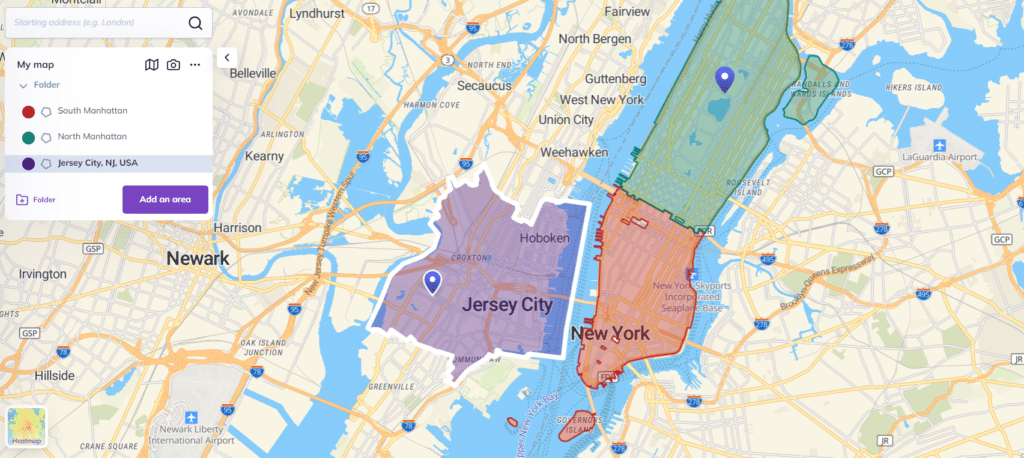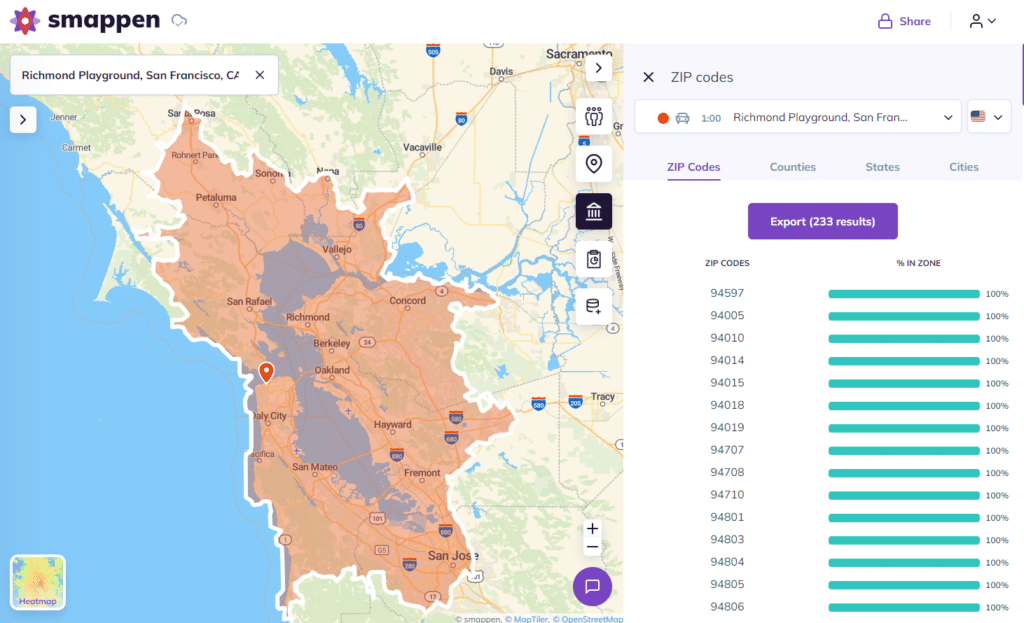TL;DR
What are the main differences between ZipCodes and ZCTA ?
While ZIP Codes focus on facilitating mail delivery, ZCTA s are designed to provide a reliable framework for demographic and geographic analysis, offering a consistent basis for statistical data.
Diving into ZCTAs
Have you ever found yourself scratching your head over the terms ZCTA (ZIP Code Tabulation Areas) and ZIP Code? You’re not alone! Let’s unravel the mystery behind these terms and discover how they can benefit your business with the help of Smappen. Whether you’re an entrepreneur, franchisor, or simply curious, this guide will provide all the insights you need.
What are ZCTAs?
The Birth of ZCTAs
ZCTAs, or ZIP Code Tabulation Areas, were born out of necessity. Created by the U.S. Census Bureau, these areas were designed to approximate ZIP Codes for census data analysis. Unlike ZIP Codes, which are primarily used for mail delivery, ZCTAs are built from census blocks. ZCTAs serve a different purpose: they offer a standardized way to present statistical data.
You might wonder why we need ZCTAs at all. Well, imagine trying to analyze population data using just ZIP Codes. ZIP Codes can be irregular and change frequently, which can lead to inconsistencies. ZCTAs, on the other hand, are more stable and align better with census data, making them ideal for demographic analysis and market research.
ZIP Codes vs. ZCTAs: what's the difference?
ZIP Codes, introduced by the United States Postal Service (USPS) in 1963, were created to streamline mail delivery. They consist of five digits (or nine, if you include the extended ZIP+4) and represent specific delivery routes within the postal system.
While ZIP Codes are about delivering your mail on time, ZIP Code Tabulation Areas are about understanding where people live, work, and shop. ZCTAs are generalized representations of ZIP Codes, but they don’t always match up perfectly. This distinction is crucial for businesses that rely on accurate demographic and geographic data.
Why Entrepreneurs and Franchisors should care about ZCTAs
Targeted Market Analysis
For entrepreneurs and franchisors, understanding your market is everything. ZCTAs provide a reliable framework for analyzing demographic data, which is vital for identifying potential customers and growth opportunities. With ZCTAs, you can delve into specific areas, examining population density, age distribution, and income levels.
Smappen's Role in ZCTA Analysis
Smappen tool allows you to visualize and analyze areas using ZCTAs. Whether you’re planning to open a new store, franchise, or simply want to understand your target market better, Smappen gives you the insights you need to make informed decisions.
Smappen Simplifies ZCTA Mapping !
Easy Visualization
Smappen’s intuitive interface makes it easy to create detailed maps of ZCTAs. You can quickly see how different areas stack up in terms of population and demographics, helping you pinpoint the best locations for your business.
Comprehensive Data Analysis
With Smappen, you don’t just get maps; you get actionable data. The platform integrates various data sources, providing a comprehensive view of each ZCTA. This includes population statistics, economic data, and more, all at your fingertips.
Customizable Zones
One of Smappen’s standout features is its ability to customize zones. You can adjust boundaries, combine areas, and create zones that perfectly match your business needs. This flexibility ensures that you get the most accurate and relevant data possible.

Site Selection
Choosing the right location is crucial for any business. By using ZCTAs and Smappen’s mapping tools, you can identify high-potential areas that align with your target demographic. This data-driven approach minimizes risk and maximizes your chances of success.
Marketing Campaigns
Effective marketing relies on understanding your audience. ZCTAs provide the demographic insights needed to tailor your campaigns to specific regions. Whether you’re running local ads or planning a nationwide strategy, ZCTAs help you hit the mark.
In the ever-changing landscape of business, staying informed and making data-driven decisions is key. ZCTAs offer a robust framework for understanding demographic data, and with Smappen, you have the tools to leverage this information effectively. Whether you’re an entrepreneur, franchisor, or simply curious, embracing ZCTAs and using Smappen can give you the edge you need.
With Smappen, you can:
- Create areas from ZCTAs and visualize demographic details within specific ones.
- Make smarter, data-driven decisions for your business.
- Easily export comprehensive ZCTA lists for analysis and planning.

FAQ
A ZCTA, or ZIP Code Tabulation Area, is a geographical area defined by the U.S. Census Bureau to approximate ZIP Codes for statistical analysis.
ZCTAs are created by aggregating census blocks, the smallest geographic units used by the U.S. Census Bureau, into larger geographic sectors based on ZIP Code boundaries. ZCTA5s provide a more accurate representation of the territories served by a ZIP5 code than the actual ZIP Code boundaries.
Geographic Coverage, specificity and usage :
ZIP5 is a five-digit code that identifies specific delivery areas such as cities, towns, or neighborhoods and is the most commonly used type of ZIP Code. It covers smaller areas, allowing identification of specific delivery routes or post office boxes. ZIP5 is more specific and is used to sort and deliver mail more efficiently. Individuals and businesses use ZIP5 for mailing purposes, and it is included in addresses to ensure accurate delivery.
ZIP3 is a three-digit code that represents a group of ZIP5 codes that share the same first three digits, also known as a sectional center facility (SCF) code. It covers larger territories, identifying groups of ZIP5 codes served by the same USPS sectional center facility. ZIP3 is less specific and is primarily used for mail processing and routing purposes. Unlike ZIP5, ZIP3 is mainly used by the USPS and is not typically included in mailing addresses.
ZIP Codes are used by the USPS for mail delivery, while ZCTAs are used for demographic and statistical purposes. ZCTAs may not align perfectly with ZIP Code boundaries.
Businesses benefit from ZCTAs because they provide reliable demographic information, crucial for market analysis, site selection, and targeted marketing campaigns.
Smappen offers a tool to create areas from ZCTAs, to visualize and analyze each ones, providing detailed insights into population, demographics, and economic data to help businesses make informed decisions.
Yes, Smappen allows users to customize zones, adjust boundaries, and combine areas to create the most accurate and relevant data for their business needs.

